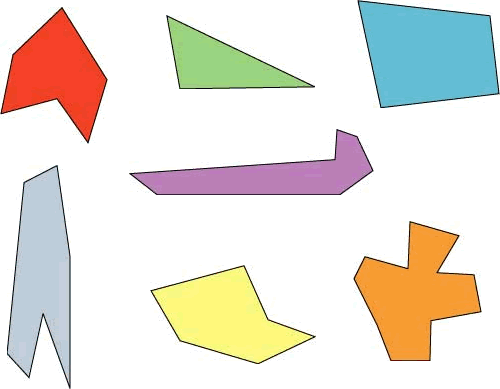Or search by topic
Number and algebra
Geometry and measure
Probability and statistics
Working mathematically
Advanced mathematics
For younger learners
Sizing Them Up



- Problem
- Getting Started
- Student Solutions
- Teachers' Resources
Sizing Them Up
Arrange these shapes in order of size. Put the smallest first.
How are you deciding on the order?

Kelsey said:
"I printed the shapes and then measured the length of each shape at the longest point."
Louise and Rosie said:
"We observed the area of each and tried to rearrange the shapes in our heads to compare them."
Thomas said:
"I cut out the shapes then cut each up into little pieces and laid them on top of each other to see which was bigger. I also put them on a grid with small squares and counted the number of squares for each."
Can you take each of these starting ideas and develop it into a solution?
You may be interested in the other problems in our Celebrating Solutions Feature.
Why do this problem?
This low threshold high ceiling activity is designed to help children begin to understand the meaning of area as a measurement of surface. It gives them a chance to choose and then justify a way of measuring. It can be solved in many different ways and the sample approaches offer a basis for discussion of possible different methods.
Possible approach
This problem featured in an NRICH Primary webinar in November 2021.
This activity is deliberately open to encourage children to try to define "smallest" for themselves. At this level, the important point is to be able to explain and justify a particular order, rather than there being any right or wrong way to do it. Children might use criteria such as length, height or perimeter, for example. The activity could lead into the introduction of the concept of area, (even if the word "area" itself is not used).
Allow at least fifteen minutes for a final discussion. Invite some pairs to explain how the three different methods might be continued, using the interactivity to keep track of the order that the pairs describe. You may find that some members of the class used completely different approaches when they worked on the task to begin with, so ask them to share their methods too. You can then facilitate a discussion about the advantages and disadvantages of each. Which way would they choose to use if they were presented with a similar task in the future? Why?
Key questions
How are you going to decide which is smallest?
Possible extension
Children could be asked to cut out shapes which they think are 'the same size' but which are very different shapes from those given.
Possible support
Some children might benefit from cutting out the shapes from this sheet and putting them one on top of another to aid comparison (laminating them may help prolong their life!).
Related Collections
You may also like
Biscuit Decorations
Andrew decorated 20 biscuits to take to a party. He lined them up and put icing on every second biscuit and different decorations on other biscuits. How many biscuits weren't decorated?

